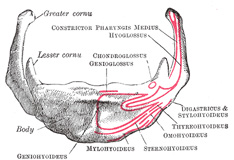| Henry Gray (1821–1865). Anatomy of the Human Body. 1918. |
| |
| 5b. 9. The Hyoid Bone |
| |
(Os Hyoideum; Lingual Bone)
The hyoid bone is shaped like a horseshoe, and is suspended from the tips of the styloid processes of the temporal bones by the stylohyoid ligaments. It consists of five segments, viz., a body, two greater cornua, and two lesser cornua. | 1 |
| | | The Body or Basihyal (corpus oss. hyoidei).—The body or central part is of a quadrilateral form. Its anterior surface (Fig. 186) is convex and directed forward and upward. It is crossed in its upper half by a well-marked transverse ridge with a slight downward convexity, and in many cases a vertical median ridge divides it into two lateral halves. The portion of the vertical ridge above the transverse line is present in a majority of specimens, but the lower portion is evident only in rare cases. The anterior surface gives insertion to the Geniohyoideus in the greater part of its extent both above and below the transverse ridge; a portion of the origin of the Hyoglossus notches the lateral margin of the Geniohyoideus attachment. Below the transverse ridge the Mylohyoideus, Sternohyoideus, and Omohyoideus are inserted. The posterior surface is smooth, concave, directed backward and downward, and separated from the epiglottis by the hyothyroid membrane and a quantity of loose areolar tissue; a bursa intervenes between it and the hyothyroid membrane. The superior border is rounded, and gives attachment to the hyothyroid membrane and some aponeurotic fibers of the Genioglossus. The inferior border affords insertion medially to the Sternohyoideus and laterally to the Omohyoideus and occasionally a portion of the Thyreohyoideus. It also gives attachment to the Levator glandulæ thyreoideæ, when this muscle is present. In early life the lateral borders are connected to the greater cornua by synchondroses; after middle life usually by bony union. | 2 |
 |
FIG. 186– Hyoid bone. Anterior surface. Enlarged. (See enlarged image) | | |
| | | The Greater Cornua or Thyrohyals (cornua majora).—The greater cornua project backward from the lateral borders of the body; they are flattened from above downward and diminish in size from before backward; each ends in a tubercle to which is fixed the lateral hyothyroid ligament. The upper surface is rough close to its lateral border, for muscular attachments: the largest of these are the origins of the Hyoglossus and Constrictor pharyngis medius which extend along the whole length of the cornu; the Digastricus and Stylohyoideus have small insertions in front of these near the junction of the body with the cornu. To the medial border the hyothyroid membrane is attached, while the anterior half of the lateral border gives insertion to the Thyreohyoideus. | 3 |
| | | The Lesser Cornua or Ceratohyals (cornua minora).—The lesser cornu are two small, conical eminences, attached by their bases to the angles of junction between the body and greater cornua. They are connected to the body of the bone by fibrous tissue, and occasionally to the greater cornua by distinct diarthrodial joints, which usually persist throughout life, but occasionally become ankylosed. | 4 |
| The lesser cornua are situated in the line of the transverse ridge on the body and appear to be morphological continuations of it (Parsons 46). The apex of each cornu gives attachment to the stylohyoid ligament; 47 the Chondroglossus rises from the medial side of the base. | 5 |
| | | Ossification.—The hyoid is ossified from six centers: two for the body, and one for each cornu. Ossification commences in the greater cornua toward the end of fetal life, in the body shortly afterward, and in the lesser cornua during the first or second year after birth. | 6 |
| Note 46. See article on “The Topography and Morphology of the Human Hyoid Bone,” by F. G. Parsons, Journal of Anatomy and Physiology, vol. xliii. [back] |
| Note 47. These ligaments in many animals are distinct bones, and in man may undergo partial ossification. [back] |
|
|


